

Rainforest animals: Zoom Rainforests. Advertisement.
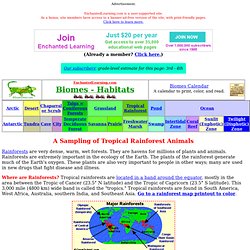
EnchantedLearning.com is a user-supported site. As a bonus, site members have access to a banner-ad-free version of the site, with print-friendly pages.Click here to learn more. (Already a member? Click here.) A Sampling of Tropical Rainforest Animals Rainforests are very dense, warm, wet forests. Where are Rainforests? Strata of the Rainforest Different animals and plants live in different parts of the rainforest. EMERGENTS: Giant trees that are much higher than the average canopy height. Click on an animal or other rainforest topic for a printout or information on that animal:
Rainforest Climates. R a i n f o r e s t C l i m a t e s Rainforests are defined—as you would expect—by rainfall, and in fact they are literally created by it.
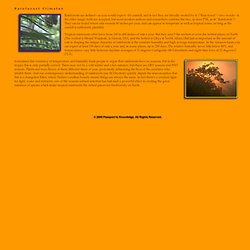
(“Rain forest”—two words—is the older usage: both are accepted, but most modern authors and researchers combine the two, as does PTK, as in “Rainforest.”) They can be found where rain exceeds 80 inches per year, and can appear in temperate as well as tropical zones, so long as the rainfall is sufficiently plentiful.
Tropical rainforests often have from 160 to 400 inches of rain a year. But they aren’t the wettest or even the hottest places on Earth. Sometimes this constancy of temperature and humidity leads people to argue that rainforests have no seasons, but in the tropics this is only partially correct. Rainforest Biomes. The tropical rain forest is a forest of tall trees in a region of year-round warmth.
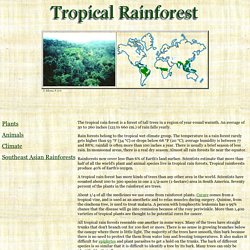
An average of 50 to 260 inches (125 to 660 cm.) of rain falls yearly. Rain forests belong to the tropical wet climate group. The temperature in a rain forest rarely gets higher than 93 °F (34 °C) or drops below 68 °F (20 °C); average humidity is between 77 and 88%; rainfall is often more than 100 inches a year. There is usually a brief season of less rain. In monsoonal areas, there is a real dry season. Rainforests now cover less than 6% of Earth's land surface. Earth Floor: Biomes. Fact sheet: Tropical Rainforest Animals. Where can you find an antelope the size of a rabbit, a snake that can fly, or a spider that eats birds?
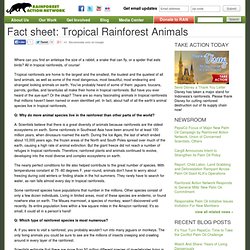
All in tropical rainforests, of course! Tropical rainforests are home to the largest and the smallest, the loudest and the quietest of all land animals, as well as some of the most dangerous, most beautiful, most endearing and strangest looking animals on earth. You've probably heard of some of them: jaguars, toucans, parrots, gorillas, and tarantulas all make their home in tropical rainforests.
Rainforest Plants. Blue Planet Biomes - Animals. The First Organisms Close to 2.5 billion years ago, the earth's surface and atmosphere were stable enough to support primitive life.
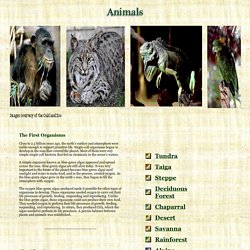
Single-cell organisms began to develop in the seas that covered the planet. Most of them were very simple single-cell bacteria that fed on chemicals in the ocean's waters. A simple organism known as blue-green algae appeared and spread across the seas. Blue-green algae are still alive today. The oxygen blue-green algae produced made it possible for other types of organisms to develop. Classification In order to study nature, scientists have classified the life forms in nature, or put them into groups. There are two main groups of animals: vertebrates and invertebrates.
Organisms in the animal kingdom consist of many different species. Animal cells don't have the rigid cell walls that plant cells have. All told, around 9 or 10 million species of the kingdom Animalia inhabit the earth; the exact number isn't known. Animal Ecology Limiting factors. Blue Planet Biomes - Plants. The Importance of Plants Close to 2.5 billion years ago, the earth's surface and atmosphere were stable enough to support primitive life.
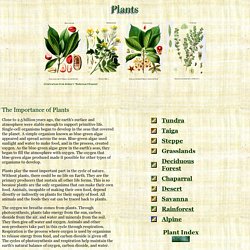
Single-cell organisms began to develop in the seas that covered the planet. A simple organism known as blue-green algae appeared and spread across the seas. Blue-green algae used sunlight and water to make food, and in the process, created oxygen. Southeast Asian Rainforests. The Southeast Asian rainforests are the oldest, consistent rainforests on Earth, dating back to the Pleistocene Epoch 70 million years ago.
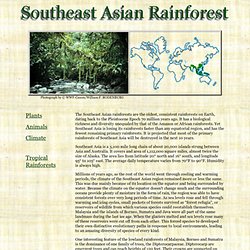
It has a biological richness and diversity unequaled by that of the Amazon or African rainforests. Yet Southeast Asia is losing its rainforests faster than any equatorial region, and has the fewest remaining primary rainforests. It is projected that most of the primary rainforests of Southeast Asia will be destroyed in the next 10 years. Southeast Asia is a 3,100 mile long chain of about 20,000 islands strung between Asia and Australia. It covers and area of 1,112,000 square miles, almost twice the size of Alaska.